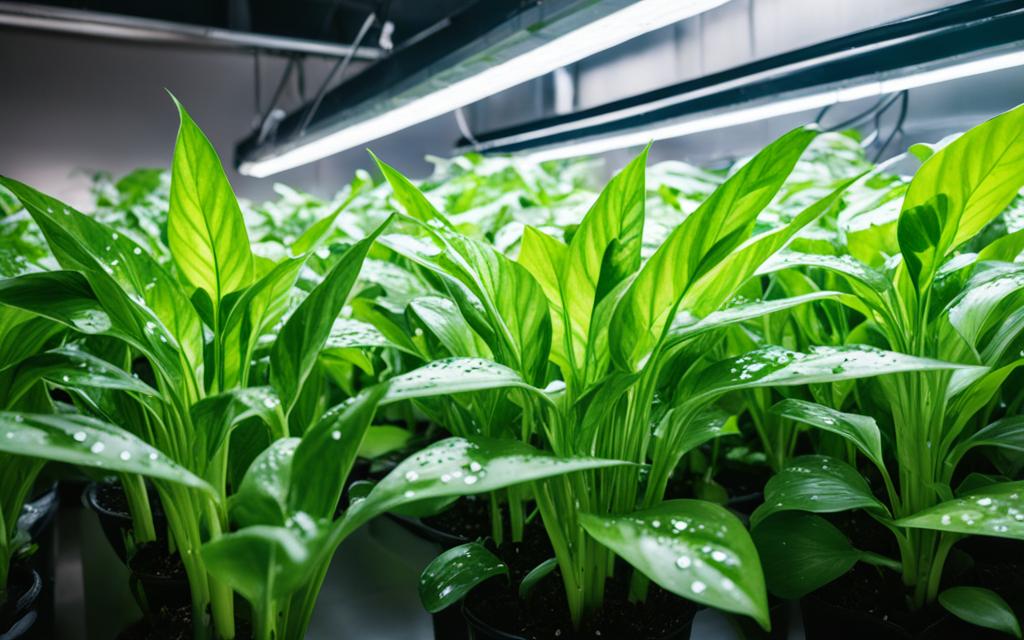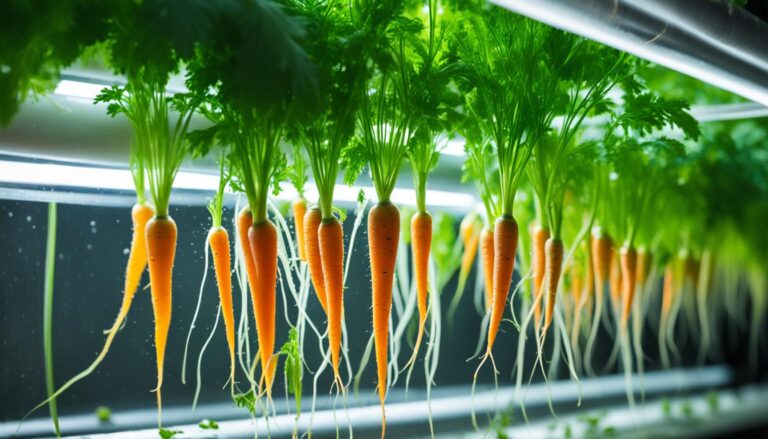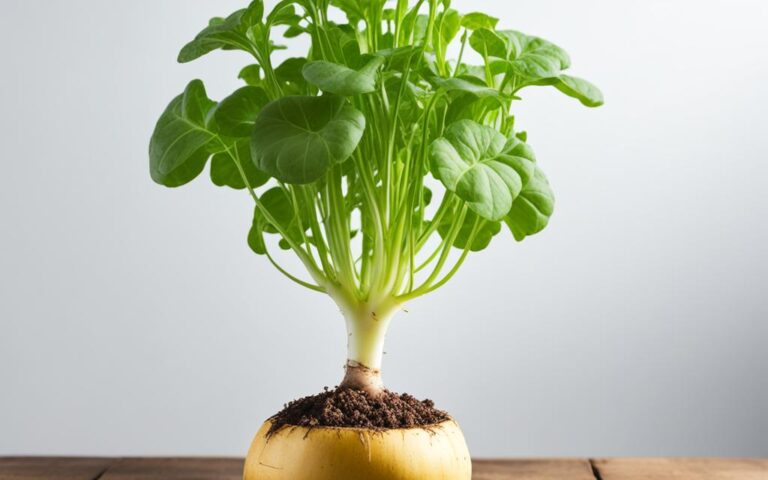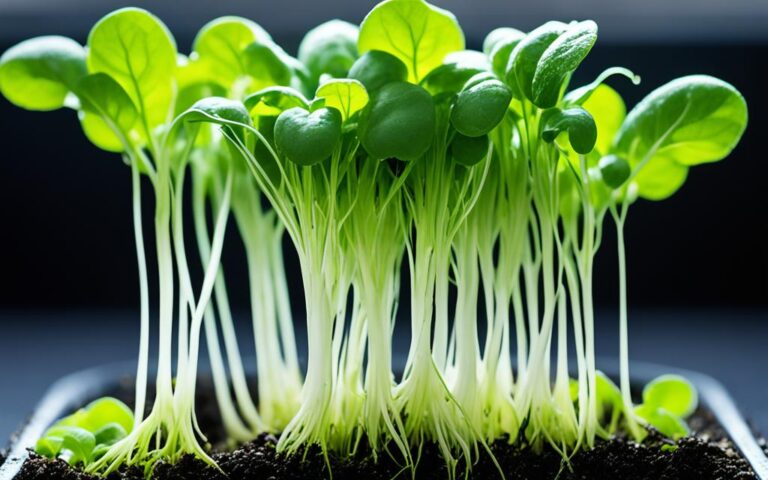Grow Hydroponic Dumb Cane with Ease
Did you know hydroponic Dieffenbachia, or dumb cane plants, can reach up to 10 feet tall? These tropical plants are easy to grow hydroponically. They also clean the air, making them great for indoor spaces. With proper care, you can enjoy their lush leaves and clean air in your home.
Key Takeaways
- Hydroponic Dieffenbachia, or dumb cane, can grow up to 10 feet tall in ideal conditions.
- Growing dumb cane hydroponically allows for precise control over nutrients and reduces the risk of soil-borne diseases.
- Hydroponic dumb cane plants are easy to grow and provide air-purifying benefits for indoor spaces.
- The right setup and care can help you enjoy the lush foliage and air-purifying properties of this tropical plant.
- Hydroponic gardening offers a controlled environment for growing a variety of plants, including low-light and air-purifying species like dumb cane.
Introduction to Hydroponic Dumb Cane
The dumb cane, also known as Dieffenbachia, is a favorite houseplant. It’s loved for its big, beautiful leaves and its ability to grow well in low light. Growing these plants in a water solution, called hydroponics, is different from traditional soil gardening.
What is a Hydroponic Dumb Cane?
These plants don’t need soil. Instead, they get their nutrients and water from a special system. This method gives plants exactly what they need, cutting down on diseases and helping them grow stronger.
Benefits of Growing Hydroponic Dumb Cane
There are many perks to growing dumb cane plants hydroponically:
- Improved growth and vigor due to the optimal nutrient delivery
- Increased air-purifying abilities, as hydroponic plants are more efficient at removing harmful toxins from the air
- Easier maintenance, as there is no need to worry about soil pH, pests, or compaction
- Suitability for growing dumb cane indoors, making it a great choice for small-space or low-light environments
- Classification as a low-maintenance houseplant, perfect for busy individuals or those new to plant care
Learning about the special traits and benefits of hydroponic dumb cane helps gardeners make the most of this versatile and clean-air plant for their homes.
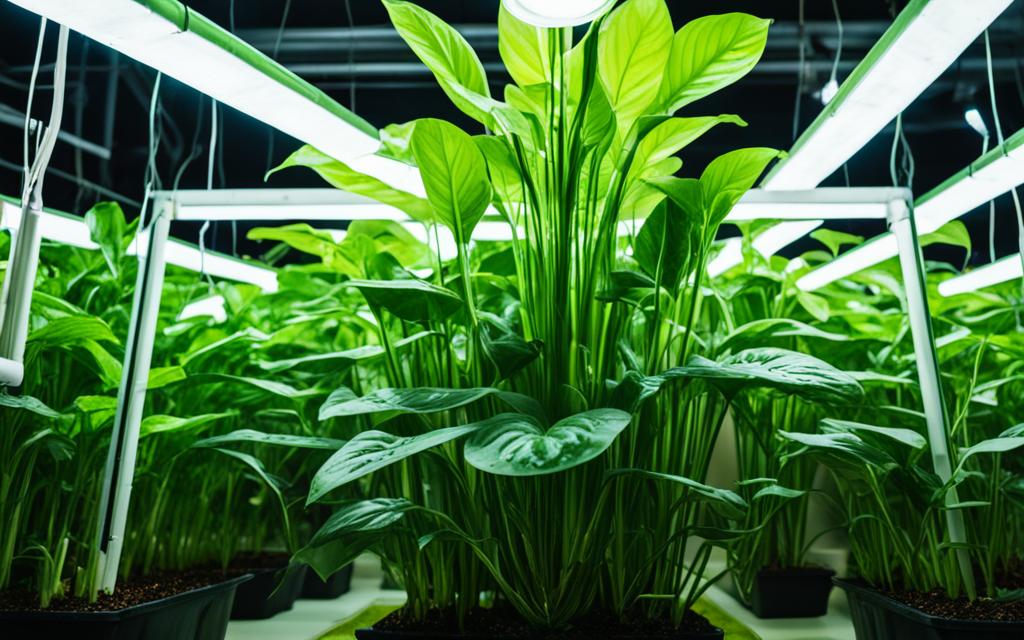
Selecting the Right Hydroponic System
Choosing the right hydroponic system is key to growing dumb cane successfully. There are many hydroponic systems for indoor growing, each with its own benefits. Each system has its own way of providing nutrients to plants.
Types of Hydroponic Systems
Popular hydroponic systems for dumb cane include:
- Deep Water Culture (DWC): This system keeps the plant’s roots in a nutrient-rich water solution. It provides oxygen and nutrients for growth.
- Nutrient Film Technique (NFT): A thin film of nutrient water flows over the roots, giving a steady supply of nutrients.
- Ebb and Flow (Flood and Drain): This system floods the roots with nutrient solution and then drains it. It mimics the natural wetting and drying cycle.
Factors to Consider When Choosing a System
When picking a hydroponic system for your dumb cane, think about these factors:
- Available Space: Check the size of your area and pick a system that fits well.
- Budget: Set a budget for the setup and maintenance costs. Different systems have varying costs.
- Plant Size: Consider how big and how fast your dumb cane plant will grow. Some systems work better for larger or smaller plants.
- Experience Level: If you’re new to hydroponics, go for a system that’s easy to start with. Deep water culture or ebb and flow are good for beginners.
Setting up your hydroponic system right is important. Make sure it has the right water flow, aeration, and nutrient delivery for your dumb cane plant.
Setting Up Your Hydroponic Dumb Cane System
Setting up a hydroponic system for dumb cane is key to its success. You need to pick the right container, ensure good air and water flow, and place it in the right spot.
Your hydroponic dumb cane setup needs a big container with good drainage. An air pump or bubbler adds oxygen to the nutrient solution. Make sure the water flow is even to feed the roots well.
For growing dumb cane in hydroponics, put it in a spot with bright, indirect light. Keep the temperature steady between 65-75°F. This setup is perfect for healthy growth and lush leaves.
| Hydroponic System Component | Recommended Specifications |
|---|---|
| Growing Container | Large enough for root system, with proper drainage |
| Aeration | Air pump or bubbler to oxygenate nutrient solution |
| Water Flow | Optimized to deliver nutrients evenly to roots |
| Lighting | Bright, indirect light area |
| Temperature | Stable 65-75°F |
Think about these important factors when setting up your hydroponic system. Doing so will help your hydroponic dumb cane grow well and look great.
Choosing the Right Hydroponic Nutrients
Choosing the right hydroponic nutrients for dumb cane is key for their healthy growth. The essential nutrients for dieffenbachia include nitrogen, phosphorus, potassium, calcium, magnesium, and micronutrients. These elements are crucial for foliage growth, root health, and plant strength.
Essential Nutrients for Dumb Cane
Nitrogen helps make leaves green and healthy. Phosphorus supports strong roots. Potassium makes the plant strong and stress-resistant. Calcium and magnesium are important for cell function and nutrient absorption. Iron, boron, and zinc help the plant use hydroponic nutrient solutions well.
Nutrient Solutions and Ratios
- Commercial hydroponic nutrient solutions are made for tropical plants like dieffenbachia.
- It’s important to follow the instructions for mixing and applying nutrients to get the right nutrient ratios for plants.
- A balanced nutrient solution gives plants the right mix of elements for growth and health.
Feeding your hydroponic dumb cane with the correct hydroponic nutrients leads to healthy foliage and strong roots. Knowing the essential nutrients and following the right nutrient solutions and ratios helps your dumb cane thrive in your hydroponic setup.
Lighting Requirements for Hydroponic Dumb Cane
Proper lighting is key for growing hydroponic dumb cane, also known as dieffenbachia. These tropical houseplants love bright, indirect light. They can handle low light but do best with the right amount of light.
Types of Grow Lights
For enough light, consider using grow lights. Here are some options:
- LED Grow Lights – Energy-efficient, long-lasting, and cover all light wavelengths.
- Fluorescent Grow Lights – Affordable and good for dumb cane’s low-to-medium light needs.
- HID (High-Intensity Discharge) Grow Lights – Very bright but need more energy and get hot.
Place the grow lights right and adjust the time to help your hydroponic dumb cane grow well. This ensures it gets the indoor lighting requirements for houseplants it needs.
| Grow Light Type | Energy Efficiency | Spectrum Coverage | Heat Output |
|---|---|---|---|
| LED | High | Full Spectrum | Low |
| Fluorescent | Moderate | Limited Spectrum | Moderate |
| HID | Low | Broad Spectrum | High |
“Proper lighting is the foundation for healthy, vibrant hydroponic dumb cane plants. By understanding the different grow light options and their benefits, you can create the ideal growing environment for your indoor plants.”
Temperature and Humidity Considerations
Keeping the right temperature and humidity is key for a hydroponic dumb cane. These plants love warm weather, doing best in 65-75°F. If it gets too cold or hot, they might drop leaves or grow slow.
Also, dumb canes need a lot of moisture, about 40-60% humidity. This keeps them healthy and bright.
To keep the air moist, try a pebble tray, mist the leaves, or put the system in a damp spot like a bathroom. Watching and tweaking the temperature and humidity will help your dumb cane flourish.
- Optimal temperature range for hydroponic dumb cane: 65-75°F
- Ideal humidity level: 40-60%
- Strategies to increase humidity: pebble tray, leaf misting, humid location
Getting the temperature and humidity right is crucial for your hydroponic dumb cane’s health and growth.
“Providing the perfect temperature and humidity environment is key to ensuring your hydroponic dumb cane thrives and reaches its full potential.”
Planting and Growing Hydroponic Dumb Cane
Growing hydroponic dumb cane can start from seeds or cuttings. Cuttings are easier and more common. Choose a healthy stem, about 6 inches long, with several leaves. Cut off the lower leaves, dip the end in rooting hormone, and put it in the hydroponic system’s medium.
In a few weeks, roots will grow, and new leaves will appear.
Transplanting and Spacing
When moving the dumb cane to a new pot, pick one that’s 1-2 inches wider than the old one. This lets the roots grow well. Also, keep plants a few feet apart to let them reach their full size of 3-5 feet tall and 2-3 feet wide.
Good spacing helps your hydroponic dumb cane grow healthy.
| Propagation Method | Advantages | Considerations |
|---|---|---|
| Seeds | – Less common method – Adds genetic diversity |
– Slower growth rate – May require more care |
| Cuttings | – Faster growth – Easier propagation |
– Lack genetic diversity – Requires rooting hormone |
Think about growing dumb cane from seeds or cuttings, transplanting hydroponic dumb cane, and spacing requirements for dieffenbachia. This will help your hydroponic dumb cane grow well and give you a great harvest.
Hydroponic Dumb Cane Maintenance
Keeping a hydroponic dumb cane healthy means paying close attention to its pH and nutrient levels. It’s important to check and adjust these often to help your plant grow well.
Monitoring pH and Nutrient Levels
The best pH for hydroponic dumb cane is between 5.5 and 6.5. This range helps the plant absorb nutrients well. Use a good pH meter to check the solution’s pH and adjust it with pH up or down products if needed.
Also, keep an eye on the electrical conductivity (EC) or total dissolved solids (TDS) to make sure the plant gets the right nutrients. Follow the product instructions for nutrient levels and refill the solution when it gets low. This careful attention will help your hydroponic dumb cane stay healthy and look great for a long time.
| Nutrient | Ideal Range |
|---|---|
| Nitrogen (N) | 100-200 ppm |
| Phosphorus (P) | 30-60 ppm |
| Potassium (K) | 100-200 ppm |
| Calcium (Ca) | 50-100 ppm |
| Magnesium (Mg) | 20-40 ppm |
Keeping the right pH and nutrient levels is key for your hydroponic dumb cane’s health and growth. Regular checks will help your indoor dieffenbachia stay strong and beautiful.
Common Issues and Troubleshooting
Hydroponic dumb cane plants are usually easy to care for but can face some common problems. Pests like spider mites, aphids, and mealybugs are often seen. Look for webbing, discolored leaves, or sticky residue to spot these pests. Using horticultural oil or insecticidal soap can get rid of them.
These plants can also get fungal diseases from too much water or bad air flow. Keeping the right nutrient levels, pH, and clean conditions can stop and fix these issues. Check your plant often and act fast if you see any problems to keep your hydroponic dumb cane healthy.
Identifying and Treating Pests and Diseases
- Spider mites: Webbing, discolored leaves
- Aphids: Sticky residue, curled leaves
- Mealybugs: Cottony masses, stunted growth
- Leaf spots: Discolored, sunken lesions on leaves
- Stem rot: Soft, mushy stems, wilting
To fix these problems, use horticultural oil or insecticidal soap for pests. Keeping the right nutrient levels, pH, and air flow can also prevent diseases.
| Pest/Disease | Symptoms | Treatment |
|---|---|---|
| Spider Mites | Webbing, discolored leaves | Horticultural oil, insecticidal soap |
| Aphids | Sticky residue, curled leaves | Insecticidal soap, neem oil |
| Mealybugs | Cottony masses, stunted growth | Isopropyl alcohol, horticultural oil |
| Leaf Spots | Discolored, sunken lesions | Improve air circulation, reduce humidity |
| Stem Rot | Soft, mushy stems, wilting | Adjust nutrient levels, improve drainage |
By keeping an eye on your hydroponic dumb cane plants and fixing common issues, they can stay healthy and strong. Always check your plants often and act quickly if you see pests or diseases on your indoor plants.
Pruning and Training Hydroponic Dumb Cane
Pruning and training your hydroponic dumb cane (also known as dieffenbachia) can make it look great. These steps are not must-do but help your indoor plant look better. They also make it grow fuller and more attractive.
When pruning your hydroponic dumb cane, be gentle. Cut off old, yellow leaves or trim stems to keep your plant the right size. Use clean shears or scissors at a 45-degree angle. Remember, the plant’s sap can irritate your skin, so be careful.
Training dieffenbachia helps it look better too. By guiding stems and leaves, you can make your plant look balanced and symmetrical. This method encourages fuller growth and stops the plant from getting too long or messy.
Regular, light pruning and training are key to keeping your indoor plant looking good. With a bit of care, your hydroponic dumb cane will be a beautiful part of your indoor garden.
“Pruning and training your hydroponic dumb cane can make a big difference in its overall appearance and health.”
Harvesting and Enjoying Your Hydroponic Dumb Cane
Growing a hydroponic dumb cane lets you enjoy its beautiful leaves at home. These plants don’t usually bloom indoors, but their large leaves are stunning. You can use these leaves in many ways, making your home look lovely.
To take the leaves, cut them at the base with clean tools. Don’t take more than a third of the leaves to keep the plant healthy. You can use the leaves in floral arrangements, as decorations, or in crafts.
Your hydroponic dumb cane can live for many years with the right care. Prune and harvest leaves often to keep it thriving. This way, your dumb cane will keep making your home look beautiful.
“Growing a hydroponic dumb cane is a rewarding experience that allows you to enjoy the plant’s beautiful foliage year-round.”
- Harvest leaves regularly, but never remove more than a third of the plant’s foliage at a time.
- Use the harvested leaves in creative ways, such as in floral arrangements or as unique decorative elements.
- Maintain optimal growing conditions, including proper nutrient levels, lighting, and temperature, to ensure the plant’s continued vigor.
Follow these tips for a thriving, long-lasting hydroponic dumb cane. It will purify the air and add beauty to your home. Enjoy growing dieffenbachia and the benefits it brings!
Tips for Maximizing Hydroponic Dumb Cane Yield
To get the most from your hydroponic dumb cane, balance light, temperature, humidity, and nutrients well. This balance helps the plant grow strong and increases its yield. Keep an eye on the hydroponic system by checking the pH and adding nutrients as needed.
Pruning and training your dumb cane makes it bushier and more compact. Proper spacing lets the roots and leaves grow fully. This leads to a bigger harvest. By following these tips and watching the plant closely, your hydroponic dumb cane will flourish.
Creating the perfect growing space and caring for your plant is key to a great harvest. With the right care, your dumb cane can thrive, giving you clean air and beauty for years.
